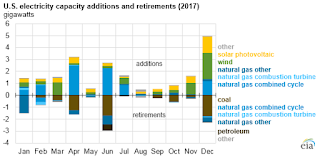The US Energy Information Administration this week published its official figures for electricity generation in 2017 and it confirms what most expected, that electricity generation from fossil fuels declined in 2017 at the same time that generation from renewables increased.
According to the Energy Information Administration’s (EIA) latest Electric Power Monthly, total net electricity generation fell by 1.5% in 2017, reflecting lower electricity demand across the country. Compared to 2016 levels, natural gas generation fell by 7.7% and coal generation fell by 2.5%, while generation from hydro, wind, and solar all increased.
As can be seen, natural gas remains the leading electricity generator for the third year running, but what is important to note is that generation from natural gas fell by 105 billion kilowatt-hours in 2017, which is the largest annual decline on record. Coal’s decrease was less than it has been in other years, but it nevertheless means that this is the first time ever that both natural gas and coal have decreased in the same year.
Coal did nevertheless manage to account for more than half of the retired electric capacity in 2017 with 6.3 gigawatts (GW) out of the 11.2 GW worth of retired electricity generating capacity and, for the first time in at least a decade, there were no new coal-fired generators added during 2017. Natural gas retired around 4 GW worth of capacity, but more capacity was added than was retired, cementing (for the moment) its lead as the country’s leading source of electricity generation.
Read more at US Fossil Fuel Electricity Generation Declined As Renewables Increased in 2017

No comments:
Post a Comment